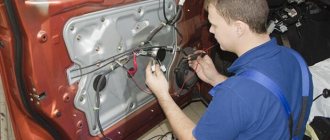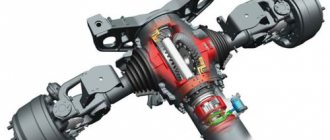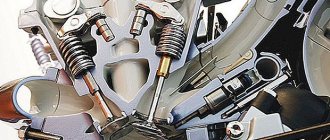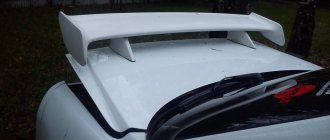Today, even inexpensive cars are equipped with smart electronics: safety has long been a priority for almost all global manufacturers. In Western countries, the requirements are stricter, and therefore the set of basic equipment is higher. Russia is still lagging behind. The mandatory minimum for passenger cars today includes a driver's airbag, ABS and the ERA-GLONASS system. Not much.
To be completely safe, autonomous cars (which we are told are the future) need to see even things that cameras, radars and sensors cannot. A global system of communication between road users is designed to solve this problem.
To be completely safe, autonomous cars (which we are told are the future) need to see even things that cameras, radars and sensors cannot. A global system of communication between road users is designed to solve this problem.
Leadership quality
Dozens of systems work for the benefit of car safety. If you take apart any of the modern models, you will find that most of the parts of these systems bear the mark of the German company Continental. one of the world's largest manufacturers of automotive components. The concern not only produces them, but also develops them independently. For testing there is its own extensive testing ground near Hannover.
For most motorists, Continental is just about tires. Perhaps someone else will remember auto parts under this brand. However, the scale of development is truly amazing. For example, such a seemingly trifle as a parking brake. The transition from lever control to keyboard control opened up new possibilities. Continental came up with a function to automatically turn on the handbrake every time the car stops. Now the car will definitely not go anywhere at a traffic light or due to the owner’s forgetfulness.
Cool tires are also a component of the active safety complex. The better they are, the less chance you have of getting into an accident.
Cool tires are also a component of the active safety complex. The better they are, the less chance you have of getting into an accident.
Modern active vehicle safety systems
Nowadays, it is almost impossible to imagine a vehicle without protective equipment. It should be noted that in modern cars, safety elements are already included in the basic package.
So, let's review the most famous security systems and their functionality.
ABS - protected braking
ABS is a German anti-lock braking system. This is a system designed to prevent wheels from locking when braking. Carrying out my task,
ABS prevents the vehicle from veering sideways, spinning, or losing control of the vehicle due to wheel locking.
The mechanism measures their speed and, based on calculations, selects the pressure of the hydraulic system of individual circuits, which gives us the opportunity to turn when braking.
Savings - no!
Passive safety systems on the vast majority of cars, fortunately, remain unclaimed throughout their service life. Still, it’s not worth saving when buying them. This is equipment that may be useful only once, but will save one or more lives.
Active safety components are an even less suitable area for savings. They work on every trip. It is these functions that prevent the driver and his car from getting into extreme road situations. No one keeps statistics, but they probably save many more lives than belts and airbags.
Think about this when choosing your next car.
Active and passive safety - what's the difference?
A century-long history of automobile safety development
If modern automakers remembered the cars from a hundred years ago, they would probably be horrified: shoe brakes and a solid steering column, like a pike, pointed at the driver’s chest. But until the 1950s, such cars were mass produced. Back then, automakers cared little about the safety of drivers and passengers; the emphasis was primarily on speed and less on convenience. And only closer to the middle of the 20th century it became obvious that car safety is perhaps the most important stage of production and should be given great attention. Let's take a look back at the fascinating history of automotive safety systems and how they have impacted the industry today. First steps
Until the beginning of the 20th century, the first bodies of cars with internal combustion engines looked more like horse-drawn carriages. Some models initially did not even have a floor, but only seats for passengers, a collapsible roof and a primitive protective front bulkhead. The engine in such cars was usually located directly under the seats. By the beginning of the 20th century, there were only about types of bodies that, following the example of carriages, had French names.
Gradually, more and more durable metals began to be used in body structures. Around the same time, there was a confrontation between open and closed bodies. Thus, the first sports car built in the USA, the 1911 Mercer Type 35 Raceabout, had an open body, while the English Lanchester had a completely hermetically sealed version. In subsequent years, automakers began to increasingly lean towards closed bodies, as they were more practical and reliable, and open versions became more of a design element.
In 1905, German mechanical engineer Frederick R. Simms installed the first bumpers on Simms-Welbeck automobiles, which were equipped with pneumatic elements to absorb impact energy. So bumpers become an integral part of the car, and American and Lincoln were the first to give their bumpers a unique appearance.
Surprisingly, already at the beginning of the last century, some cars were capable of reaching speeds of 100 km/h, so there was an urgent need to install an effective braking system. Oddly enough, the first ones were the more familiar disc brakes, patented by the Englishman Frederick Lanchester in 1902. However, they never became widespread, as they created a lot of noise and grinding noise when used.
Until the 1940-50s, first band brakes, and then drum brakes, the pads of which were securely hidden inside the drums, gained great popularity. At first, brakes were installed only on the rear wheels. A braking system for all four wheels appeared only in 1910 on the Arrol-Johnston model. The first hydraulic brakes appeared in 1921 on the Model A Duesenberg. The hydraulic brake system required great effort when pressing the pedal, so in 1923 Louis Renault invented and patented the first mechanical booster, which was installed on all production Renault cars. The first dual-circuit braking system (mechanical and hydraulic) began to be installed only in 1966 on Volvo cars.
With the increase in speed and the number of cars, engineers are beginning to implement systems to facilitate the driving process and eliminate many dangerous moments on the road. Thus, by 1916, most American cars were already equipped with windshield wipers, and by the early 1920s, the first electric headlights began to be installed. In 1938, all Cadillac production cars had rear view mirrors, windshield wipers and fog lights.
In 1928, Ford A cars were first equipped with impact-resistant windshields. Thanks to the work of Scotsman John Boydle Dunlop, who in 1887 invented and patented an inflatable bicycle tire, his invention quickly migrated to cars. Thanks to this, traveling by car has become much safer and more comfortable. In 1904, Continental developed the first textured tires, which significantly improved vehicle handling. The first radial tires were developed by Michelin in 1946. By the way, such tires are still widely used today. In 1912, American Edward Budd invented the first all-metal body in his workshop, which became widespread only in 1928.
With the growing popularity of racing, automakers began to pay more attention to the handling of the car, so in the 1930s they began to produce cars with monocoque bodies. This was achieved by combining an all-metal body with a rigid frame. As a result, the maintainability and durability of the load-bearing elements have increased with a noticeable reduction in the total weight of the vehicle. The first production car with a monocoque body was the front-wheel drive Citroen Traction Avant produced in 1934. Later, instead of a supporting body, a supporting frame was installed on cars, which provided a lower landing of the car, additional body protection and noise reduction. The first such cars were the serial "Volkswagen KdF" produced in 1939.
Passive safety
By the 1950s, cars gradually began to become not just a luxury item, but a common means of transportation, requiring increased safety for the driver and passengers through the introduction of various systems and devices, which in the future became known as passive. In the late 1940s, Volvo developed the concept of a high-strength frame (“living capsule”) that reduces impact forces. In the future, the Swedish company will make a significant contribution to the development of automobile safety, but first things first. In the middle of the last century, many automakers began to do their own crash tests of cars.
In the early 1950s, Daimler-Benz employee Bela Barenyi, later recognized as the “father of passive car safety,” proposed a revolutionary idea for creating a safe passenger compartment at that time.
The concept was a combination of an impact-resistant “living capsule” that had enough free space for passengers and crushable energy-absorbing zones at the front and rear of the car. The essence of the technology was the conversion of kinetic energy due to the deformation of body elements. Thus, the time of contact with the obstacle increased approximately tenfold, reducing the load in inverse proportion.
The development received public recognition and passed many crash tests, including frontal impact tests. The first cars on which energy-absorbing body elements began to be used were American premium class passenger cars "Packard", produced since 1952. The first car that fully incorporated the principles of passive safety proposed by Barenyi was the Mercedes-Benz W111, which entered the market in 1959 G.
In 1954, the same Bareny proposed a prototype of a steering column with a folding element, which in the event of a collision did not cause severe injuries to the driver. For a long time, the development remained in the shadows, but after a few years it showed its complete advantage over telescopic rigid structures.
In 1956, Ford began serially equipping its cars with five-point seat belts, but the technology never became widespread. By the way, the first patent for a car seat belt was issued to the American Edward Claghorn back in 1885. At the beginning of the 20th century, seat belts were most often used by racers and airplane pilots. The situation changed radically when, in 1959, Volvo began equipping its production cars with a reliable three-point seat belt. The development, as is commonly believed, was not innovative: the first three-point seat belts appeared back in 1902. However, the engineer of the Swedish company, Nils Bohlin, managed to significantly refine the technology and make it as reliable and easy to use as possible. Bolin spent more than a year developing the belt, and during that time he studied about 20,000 accident reports.
Following Volvo, by 1964 all new American cars began to be equipped with three-point seat belts, and two years later the device became standard in the United States. In 1960, Volvo began installing a padded dashboard in its production cars, which reduced the number of injuries to the face and chest. The company was also one of the first to begin testing child safety seats in 1964 and installing them on their cars.
It is worth noting that until the early 1960s, child seats were not considered a safety feature at all, but were used to raise the child to the eye level of other passengers. In 1978, the United States became the first country to pass a law requiring the transportation of children in special restraint seats. Another significant Volvo invention in 1967 was seat head restraints, which protected occupants' necks and heads in rear impacts, becoming standard in the United States two years later. In this form, head restraints lasted on the market for almost 30 years, and only in 1995, active models first appeared on the Saab 9-5, which, due to the force of inertia, activated a special mechanism that brought the head restraint closer even before the head tipped over, thereby reducing the force of the impact. Saab was also the first company to install energy-absorbing windshields on production cars in 1971, and side protective beams in the doors in 1977.
Gradually, the material of car bodies became stronger and lighter, and interior elements began to be made of crushable or soft materials. But perhaps the most important element of passive safety remains airbags. The first experiments with inflatable airbags to protect the driver and passenger sitting in the front seat were carried out by American engineers back in 1968, and only five years later they appeared at about the same time in production cars of General Motors and Chevrolet.
For the first time, an electronically controlled airbag was introduced on Mercedes S-class cars in 1980. Since then, airbag technology has undergone many changes (analyzing the position of passengers before an impact, adjusting the operating algorithm depending on the situation), but the general principle of operation has remained unchanged. this day. The great success of frontal airbags led to the fact that in 1994 Volvo introduced the 850 model, which featured side airbags combined with stiffeners installed in the front doors. The company decided to go even further and installed inflatable curtains on the S80 sedan to protect passengers in the event of a side impact. In 1996, Kia equipped its Sportage SUV with knee airbags.
In the mid-2000s, at the initiative of international organizations for the protection of pedestrians, safety hoods began to be installed on cars, which, with the help of squibs, can automatically rise to protect pedestrians during a collision. One of the first cars with this technology were the Jaguar XK and Citroen C6. In 2012, the same Volvo began installing pedestrian airbags built into the hood on the V40 model.
Active safety
Until the beginning of the 21st century, developments were carried out mainly to improve passive safety by improving the body and various systems; and not in vain - over half a century, the structural safety of cars has increased several times, allowing thousands of lives to be saved. But evolution does not stop there: already created technologies are constantly being improved, new materials are being created, and so on. Recently, emphasis has been placed on the introduction of active safety systems - technologies that reduce the share of the human factor during an accident. And although this stage is still at the stage of its active development, a lot has already been done.
It all started back in the 1970s, when Mercedes-Benz and several other companies began developing an electronic anti-lock braking system (ABS), which prevents the wheels from locking during emergency braking, thereby helping the driver not to lose control. This technology first appeared on the Mercedes-Benz 450 SEL in 1978 and then began to be installed on many domestic and foreign cars.
In 1995, Mercedes introduced the first practical solution to a technology that simplifies the parking process, called Parktronic. The system consisted of several ultrasonic sensors and a beeper indicator (buzzer). The principle of operation of the technology was quite simple: sensors measured the distance to an obstacle, and a beeper, by changing the sound signal, warned the driver when to stop.
From 1987 to 1992, Mercedes-Benz, together with Bosch, was developing an electronic stability control system for the vehicle during sudden maneuvers called the “Electronic Stability Program” (ESP). In 1995, the technology was refined and called “Electronic Stability Control” (ESC). The first cars to be equipped with such systems were the Mercedes A-class, produced in 1997.
The mid-1990s saw the rise of GPS technology with artificially low accuracy to within 100 meters. Permission to use the system for civilian purposes allowed the introduction of new automated systems into cars. In 1997, Mercedes cars, and two years later the BMW e38 and Toyota Celsior, began to use adaptive cruise control technology, which allows them to automatically maintain a set speed.
Cruise control depends on the ABS and ESC systems - if they malfunction, the function is disabled. In 1997, the European Committee began its work to conduct independent crash tests of cars with Euro NCAP assessment of passive and active safety. The Volvo S40 becomes the first car with 4 stars for adult occupant protection, and the first 5-star holder is the Renault Laguna in 2001.
In 2007, Volvo introduced blind spot monitoring technology on the S80 sedans, and a year later equipped the XC60 with another innovative development - autonomous braking. You can read about other new products in the world of automotive electronics and security systems on our blog.
Bottom line
Of course, it is impossible to fully describe the evolution of automotive safety systems in one article. The only thing that can be said with certainty is that in just over a hundred years the car has changed beyond recognition. Now it is no longer just a means of transportation, it is also a platform for the introduction of innovative technologies. In recent years, most companies have switched to developing self-driving cars, which require the creation of new safety systems.











